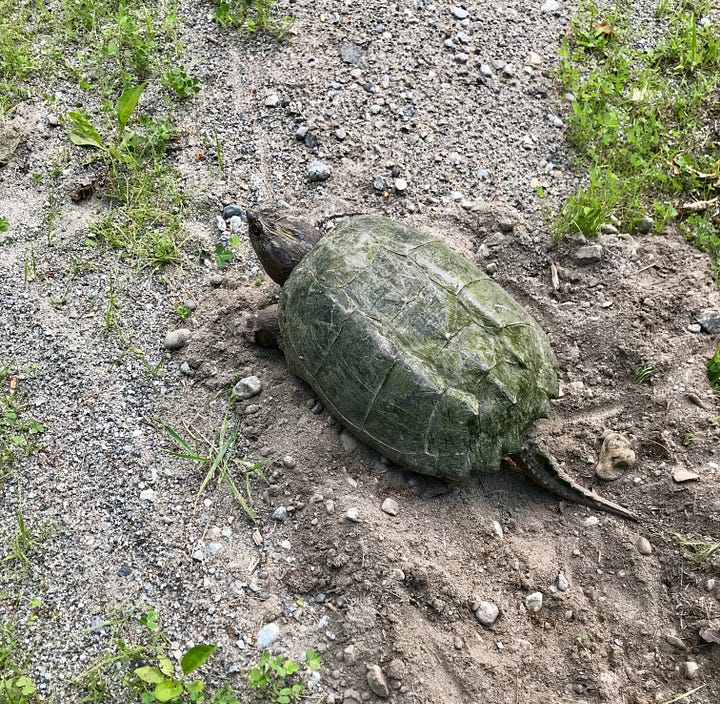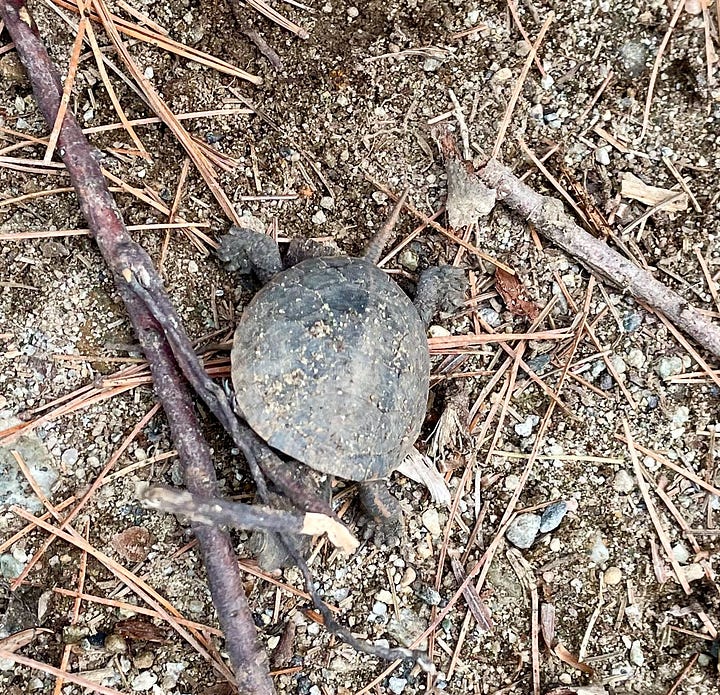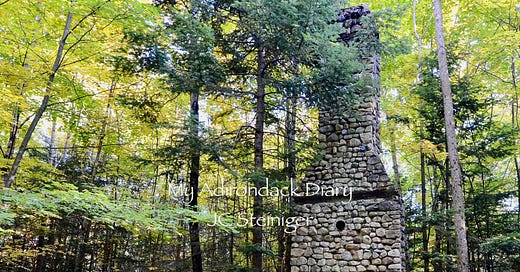April 26, 2025
One of the first signs of spring is an opening in the ice on the pond, right where a small stream enters. The opening will gradually expand along the shoreline, and the new entrance to the water will attract mink, and occasionally otters, which will return from their underwater fishing trips to eat their catch along the edge of the ice. Over a few weeks’ time the entire pond shoreline will become open water, while a gigantic ice flow floats in the middle of the lake. A stiff breeze can send the ice flow careening around the pond, sometimes shearing homeowners’ 4”x4” dock posts like matchsticks. The last ice to melt is usually along the southwest shoreline, which is shaded from the sun.
Some winter ice remains in the coves on the south shore of the pond.
A gathering pile of white birch logs on my neighbor’s property are chiseled to pencil points on each end, waiting to be dragged to a beaver’s underwater food cache next to the beaver lodge farther down the shoreline. White birch has a limited lifespan and will usually succumb to heart rot or some other disease before they get very large. On a beaver pond they never get to die of old age as white birch is a beaver’s second favorite snack, after willow.
Spring usually arrives late here in the Adirondacks. Adirondackers are still plowing snow from their driveways when downstate communities are already hosting tulip festivals, but there are signs here that spring is coming. The first indication is often the reappearance of “the girls”, our group of whitetail deer, seven this winter, that had been sheltering in an upland stand of large pine. The tree cover keeps the snow from accumulating to depths that make it difficult for the deer to get around. When I see them back under our birdfeeders, I know that the snow depths are receding up in the mountains. It’s always good to see that they survived another Adirondack winter. Flocks of turkeys will join them under the feeders, scavenging the dropped seeds scattered by the chickadees. An early arrival this spring was a sharp-shinned hawk, much to the dismay of our resident chickadees, who are lunch for a very hungry hawk after flying in from its winter home down south. I have not heard the broad- wing hawk that usually nests in the woods up behind the barn and I am wondering if the new sharp-shinned is the reason.
A sharp-shinned hawk. (Our chickadees were not amused.)
We have been listening to our local barred owls’ familiar “who-who-who cooks for you” nightly calls since February, the time when these owls usually nest. When the snow gets deep in mid-winter, owls have difficulty locating their prey, typically mice and voles living in the subnivean zone in the snowpack just above the ground. Even an owl’s acute hearing has a hard time penetrating many feet of snow, so they will substitute birds and small squirrels that they find around our birdfeeders. When migrating slate juncos appear on the ground under the feeders, I know that spring is almost here, and it is time to take the feeders down before the bears, hungry after a long winter’s nap, do it for me.
The first sign of color is usually in the willows, which start to take on a yellowish hue when daytime temperatures get above freezing. As the weather has warmed, those colors arrive a little sooner each year. Soon after the vernal pools around the property have shed their winter ice, a chorus of peepers in each of them will serenade us at sundown each evening as they sing for a mate. The chorus diminishes over time, until after a few weeks we will hear just a few peepers calling, and then finally one, single, and I assume very unattractive, frog.
There is a marshy area around the stream near the pond. A few years ago, I pilfered three cattails from a neighbor and planted them there. It took a year for the plants to acclimate to their new home, but in year three their number doubled as six cattails appeared, spreading by rhizomes from the original plants. In May of last year twelve green cattail shoots sprouted up from the rubble of last year’s plants, doubling again. I am hopeful that this exponential growth will result in a stand of cattails large enough to attract red-winged blackbirds, which like to nest in these plants.
For many Adirondackers, the official declaration of spring is occasioned by the arrival of our resident loons. Many Adirondack lakes are home to common loons, which summer in their Adirondack breeding grounds and winter along the east coast from New England to the Carolinas. It used to be thought that the birds mated for life, but more recent research has shown that their loyalty is to the lake that they summered at the previous year, not necessarily their mate. If a male is displaced by a rival, the female will generally stay on the lake and mate with the interloper. The loon’s arrival each spring is uncannily consistent. If the ice goes out on the lake on Tuesday, it is not unusual for the first loon to arrive by Wednesday. The males typically arrive first, with the female showing up a few weeks later. Our male resident loon arrived in mid-April, the day after the ice went out and our loon nest raft was anchored in place. A second loon, I assume the female from last summer, arrived a few days later. Males will immediately start looking for a suitable nesting site and will return to last summer’s nest site if they successfully raised a chick.
Loons have difficulty breeding successfully. Loons are designed primarily for swimming and diving, not for walking and flying. Their bones are not hollow like most birds. That additional weight provides ballast for diving and is also the reason that they sit so low in the water. Their wings are small to provide less friction underwater while diving for food but is also the reason that they need a very long “runway” to get off the water. Their very large webbed feet are situated far back on their bodies to help diving and swimming underwater but that also is the reason that they walk on land with great difficulty. If loons sound a lot like penguins that is because their closest genetic relative actually is the penguin.
Because loons have difficulty getting around on land, they build their nests right at the water’s edge to facilitate entry. That presents a problem if the water level changes while there are eggs in the nest, as the rising water can swamp the nest, and the eggs. Mortality is very high from flooding, and from marauding bald eagles, which are their primary predator. Scavenging raccoons, bears, coyotes, and fox also take their toll on the eggs. A loon has only a 50% chance of raising just one chick each summer. Here in the Adirondacks the Adirondack Center for Loon Conservation is attempting to bolster the breeding success of the loon population by providing protective floating loon “nest rafts” on select bodies of water that have resident common loons each summer. There are currently thirty-four loon nest rafts in operation, monitored by a network of volunteers. Each spring the rafts are floated immediately after ice out, and if all goes as planned, the loons accept the offering as a nesting site for the season.
Loon “nest raft” from Adirondack Center for Loon Conservation
The common loon is arguably the most recognizable symbol of the Adirondack north country but its future presence is imperiled by climate change and warming temperatures. Loon breeding territory stretches from the Adirondacks to northern Canada, but we are right at the southernmost tip of their breeding range. One hundred years ago, there were loons as far south as Pennsylvania. Climate change has caused them to move their summer breeding territory farther north. It is hard to imagine an Adirondack evening without the calls of our loons echoing over the lake, but unfortunately that is a very real possibility, if not a probability.
Each spring, as the ice over the lake recedes, the warming water temperature triggers a sequence of natural events. Water is densest at 4ºC, approximately 39ºF. When the melting ice water at the lake’s surface reaches that temperature, the greater density causes it to sink, initiating the annual spring “lake turnover”. The bottom of the lake has been starved of oxygen all winter, with sediment decomposing on the lake bottom. The seasonal turnover brings a fresh supply of oxygenated water to the lower reaches of the lake, and also serves as a wakeup call for the turtles and amphibians overwintering in the mud.
Turtles will leave the lake to lay eggs any time after ice out until November, but peak nesting season is usually in early June. Females will find a sandy patch of soil to dig out a nest and bury her eggs. Unfortunately, busy roadsides often meet that description. I always carry a large shovel in my truck to pick up traveling turtles in May and June. (Always put them down in the direction that they were traveling.) Eggs usually hatch in about three months, but hatchlings from late nestings sometime overwinter and will climb out of the nests and return to the ponds the following spring. The pictured hatchling (2.) was leaving such a nest last April.


1. Female snapping turtle laying eggs. 2. Hatchling leaving the nest.
In late April or early May, when water temperatures reach 42°F, larger lakes with resident smelt populations will see a spawning run up the larger streams feeding into the lake. Anglers target not only the smelt, but the trout and salmon that will be feeding on the spawning fish. As water temperatures reach 50°F the temperature and other factors trigger the spring spawning run for rainbow trout, which must leave the lake and find sandy spots in rivers and larger streams to lay their eggs. Rising spring water temperatures trigger a succession of fish nest construction along the lake shores. As temperatures approach 60°F, blue gills and small mouth bass appear in the shallows and under the docks, fanning debris away from the lake bottom to prepare their nests for this year’s offspring.
As the larger fish come up from the deeper lake water to feed and spawn, our resident bald eagles and ospreys appear, looking for lunch to bring home to their own offspring. The great blue herons arrive at the nearby rookery in the Hoffman Notch Wilderness Area in February or March to spruce up their nests and lay their eggs, which will hatch just as the ice is disappearing from the surrounding ponds. Here on our pond, herons fly in each morning to search for small fish and frogs to bring back to their chicks.
A great blue heron visiting the pond to fish.
As I write this, our recently arrived robins and eastern phoebes are checking out every nook and cranny in the house and are jostling for locations to build their nests. Often, they will repeat the process in mid-summer and raise a second clutch of eggs.
One of my favorite spring residents is our Canadian bunchberry plant, which reappears each spring seemingly from nowhere from a tiny fissure in a large glacial erratic near the back of the house. I look forward to its annual appearance every bit as much as the first loon sighting or the first spring song of the white throated sparrows.
Canadian Bunchberry growing from a glacial erratic (large boulder).
It is my favorite time of year here in the Adirondacks, even more so as I age. All of nature is immersed in its annual celebration of rejuvenation and rebirth, accompanied by a symphony of nesting songbirds and the call of the loons. It makes you glad to be alive and witness it one more time.
Now it’s time to go plant the peas.
Comments and suggestions are always welcome, as are Shares (!) If you like what you have read, and you would like to receive a Saturday morning email with the current week’s Adirondack Diary update, please consider subscribing. All posts are public and available for free.
Join me on BlueSky @northcountryjoe.bsky.social










The last ice to melt around here in Lancaster, PA is usually in a glass of Bourbon.
Great post that brought back a lot of spring memories from Star Lake. Thank you.